14
Lefse Making - Team Work at the Laft Hus1990's - 2000's
Heritage Square, Red Deer, Alberta
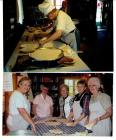 Credits:
Credits:Norwegian Laft Hus Society
Top Photo is Margaret Brereton rolling out potato lefse
L to R bottom are Syneva Baltimore, Karen Barnabe, Margaret Buckley, Leona Knopf and Anne Manca
15
Lefse Making1990's - 2000's
Heritage Square, Red Deer, Alberta
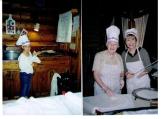 Credits:
Credits:Left is Sigrid Grosseth, 7 yrs old, daughter of Brian Grosseth and Helen Bergstrom
Right is Anna Marie Hazanoff of Red Deer and Sidsel Saetre of Trysil, Norway
16
Lefse Making - expert lefse bakers1990's - 2000's
Heritage Square, Red Deer, Alberta
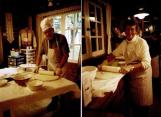 Credits:
Credits:Left is Fred Johnson
Right is Edith Braithwaite
17
Lefse Making - Syneva Baltimore1990 - 2000's
Heritage Square, Red Deer, Alberta
 Credits:
Credits:Norwegian Laft Hus Society
18
Lefse Making - Margaret Cameron1980's
Heritage Square, Red Deer, Alberta
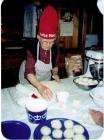 Credits:
Credits:Norwegian Laft Hus Society
19
Making Kransekake Rings1980's
Heritage Square, Red Deer, Alberta
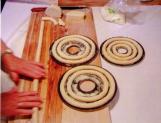 Credits:
Credits:Norwegian Laft Hus Society
20
Kransekake - Norwegian Cake1980's
Red Deer, Alberta, Canada
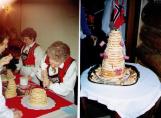 Credits:
Credits:Left to Right is Betty Wulff & Hilda Gottschlick
21
Hilda Gottschlick and Norwegian Kransekake Wedding Cake1980's
Heritage Square, Red Deer, Alberta
 Credits:
Credits:Hilda Gottschlick of Gull Lake, Alberta
Norwegian Laft Hus Society
22
Lefse Recipe - Norwegian Laft Hus Techniques for making Lefse1980 - 2007
Red Deer, Alberta, Canada
Laft Hus Recipe for Making Lefse
36 cups water
1/2 lb margarine
2 cans (385 mL size) evaporated milk
3/4 cup sugar
1/4 - 1/3 cup salt
1 bag (2.5 kg) McCain instant mashed potatoes
Mix first 5 ingredients together and bring to a boil. Then slowly add instant mashed potatoes while mixing with the mixing attachment on a drill. When well mixed, spread out on large trays or cookie sheets to cool. When completely cool, put two margarine or cottage cheese containers (500 mL size) in each plastic bag. Leave these in a cool place until morning.
For lefse, with electric mixer, mix one margarine container of flour in with each bag (consisting of 2 margarine containers) of potatoes. Mix well and then form into roll. Cut roll in half and halves again and then quarters, so you end up with 16 balls. Let balls set for about 15 - 30 minutes before rolling out as thin as possible with your well-floured rolling pin (preferably a grooved lefse rolling pin with a rolling pin cover on it) on your well-floured circle pastry canvas board (14" in diameter). Your lefse circle should end up 12 - 14 inches in diameter. Using your lefse stick, place on medium to hot lefse griddle. If bubbles start to form, flatten with lefse stick. After turning the lefse until both sides are flecked with brown, place between dampened terry towels to steam.
MAKE SURE THE CONTROLS ON YOUR LEFSE GRIDDLE ARE CHANGED AFTER 1 HOUR OR THEY WILL BURN OUT. If you don't have extra controls, then turn your lefse griddle off for a while. After lefse has steamed for a couple hourse, then spread them out on your clean tablecloth to cool. Make sure they are completely cool before packaging or they will go sour.
23
Lefse Recipe from Laft Hus - Smaller Quantity1970's - present day
Heritage Square, Red Deer, Alberta
Lefse Recipe - Smaller Quantity
2 cups water (boiling)
2 cups instant potatoes
3 Tbsp shortening
3 Tbsp butter
2 Tbsp salt
1 Tbsp sugar
Please contact Norwegian Laft Hus for method of preparation and some useful tips that make this a fun and easy task!
Credits:
Norwegian Laft Hus Society
Betty Wulff
24
GommeGomme ….. a Sweet Stove-top Cheese (well worth the effort)
Gomme is made all over Norway, each is slightly different but this recipe is from Hatlestad gard i Viksdalen, Gauler, Sunnfjord, Norway…..
This, 'Ekte Bonde Mat' (genuine farmer food), was made by my grandmother, Olga Johansdatter Sande (1890-1985), and intern had learnt it from her mother: Marta Hatlestad (1854 - 1931) of Viksdalen; this recipe was written down by me, Olga's grandson Brian Grosseth, Nov 2006. This process was as I remember my grandmother making it on her wood stove in the 1950's.
This process may take from 6-8 hours to complete. Start it in the early morning and it may be done by coffee time in the afternoon. The more Gomme that you make, the longer the cooking process will be. You can do a smaller batch, but why? Four quarts is ideal. I have never found a person that did not like this Gomme. I keep it in the fridge for several days, but the Gomme has never lasted long enough to find out its potential life expectancy.
In a large pot put 4 quarts of Whole Milk
Bring to a slow simmer
Add about 1/2 quart cultured milk or more, It must have a live culture: 'Kefir Mjolk' or'Cultured Butter Milk'. (Please note that some of the cultured milks do not contain a live culture and these will not work). This cultured milk should turn the hot whole milk into curds and whey after a short time. Things should start to look grainy at first and after a while be quit obviously 'curds & whey'. Note: the more that you stir it, the finer the cheese, I stir gently so it is not too fine, stir gently only to keep the bottom clear of most build up. Use a flat wooden stirring spoon or paddle. There will be a very slight coating on the pot bottom but do not worry about this.
Continue 'slow simmering' on a very low heat. The Milk must not scorch at all, the heat should be really quite low. In the old days it was done on the wood stove and set off to the back and side so it could just keep it hot with some steam slowly rising from the pot. The liquid on the bottom is the whey and usually does not burn, but stir every 5 - 10 minutes or so and every time you walk by the stove.
After most of the liquid is gone (evaporated) it is near done. The curds will be light brown and still be sitting in some liquid. A you stir it the reduced mixture will look slightly soupy but certainly not dry, there should be some liquid left, kind of like a very wet cottage cheese, the liquid should be easily be seen.
Add a good handful of raisins and let them soften in the liquid. After about 5 minutes mix together: 3 tablespoons of sugar with about 1 - 2 tablespoons of flour and stir into the Gomme, and finally add about 1/2 tsp cardamom (Cardamom was not used by my grandmother as far as I know, this is my personal touch), and that is it, the Gomme is near ready.
Remove from heat, place into a small attractive serving bowl and fill so that it comes near the top and pat it down gently. It should still be the consistency of a slightly dryer than creamed cottage cheese, but certainly not soupy. Dust the top with an attractive sprinkle of cinnamon then place in a cool place to set up, or serve it directly. It should make about 3 small bowls of Gomme. I have a special ornate china bowel with a lid; I use it only for Gomme, my Gomme Dish'.
At 'Coffee Time': Set a Bowl Gomme on the table with a small decorative spoon. The Gomme is to be eaten on: sliced & buttered Bread or cold & previously buttered & separated heart shaped waffles (Norwegian Style) and served with either tea of Coffee.
Vaer så god
25
AquavitLinie Aquavit - Skal!
Norway is proud to offer one of the world's smoothest aqauvit's. This is the Linie (means 'equator') Aquavit (means 'water of life'). This special spirit must make two crossings over the equator in the holds of the Wilhelmsen Line's ships on their pasages to and from Australia. The spirits roll around inside the oak casks and are subject to sharp temperature changes. Historically, the label we see today on the Linie Aquavit would indicate the name of the shp on whch the aquavit travelled and the dates of the voyage.
Credits:Uilani Brink
26
Artifacts at Laft Hus - Ale Bowl with Ornate Horsehead DesignRed Deer, Alberta, Canada
 Credits:
Credits:Aaron Swenson